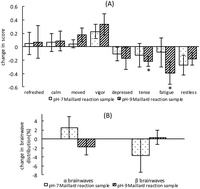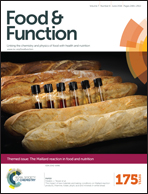Effects of odor generated from the glycine/glucose Maillard reaction on human mood and brainwaves
Abstract
Effects of the odor generated from the glycine/glucose Maillard reaction on human mood and brainwaves were investigated in the present study. Equimolar solutions of glucose and glycine were adjusted to pH 7 and pH 9 and heated at 90 °C for 30 min. The odor generated from the glycine/glucose Maillard reaction significantly decreased negative moods. Its effects on brainwaves differed according to pH; alpha brainwave distribution was increased after inhalation of the odor generated at pH 7, whereas it was decreased by the odor generated at pH 9. The effects on mood and brainwaves were also measured after inhalation of model solutions, which comprised of potent odorants determined by aroma extract dilution analysis (AEDA), and the results were similar to those obtained with the Maillard reaction samples. Therefore, odors constructed by potent odorants could influence human mood and brainwaves. Among all potent odorants, 2,3-dimethylpyrazine and 2,5-dimethyl-4-hydroxy-3(2H)-furanone (DMHF) were identified as the strongest, and high pH values resulted in higher yields of these odorants. Furthermore, DMHF was identified as the putative agent responsible for the decrease in alpha brainwave distribution after smelling the pH-9 Maillard reaction sample since higher concentrations of DMHF resulted in a similar effect.

- This article is part of the themed collection: The Maillard reaction in food and nutrition

 Please wait while we load your content...
Please wait while we load your content...